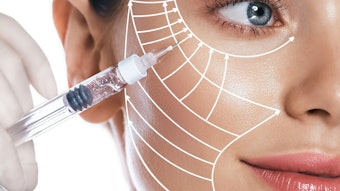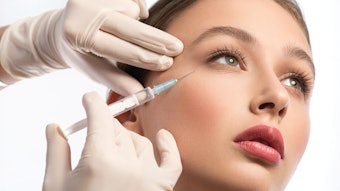
Noninvasive body contouring continues to generate enormous interest among patients, allowing them to lose fat, tighten skin and reduce circumference without any scarring or downtime. One of the key benefits to practices offering these procedures is that they appeal to a wide range of patients and generate a high rate of repeat visits.
Current Options
There are three key technologies in the noninvasive body contouring arena. They include cryolipolysis, high-intensity focused ultrasound (HIFU) and radiofrequency (RF). Only two—cryolipolysis and HIFU—are FDA-cleared for fat destruction, but that may soon change. A recent study by David McDaniel, MD, et al, published in the Journal of Drugs in Dermatology (November 2014), revealed that monopolar RF energy causes apoptosis of adipose cells in porcine models.
Until this finding makes it to clinical trials, RF energy is primarily touted as offering skin tightening, due to volumetric heating of the deep dermis, resulting in a reduced circumference of treated areas.
“Patients really like the RF-based BTL Exilis, and the upgraded Elite system delivers even better results,” says Lisa A. Zdinak, MD, chief surgeon at Precision Aesthetics NYC in New York City. “Patients can feel the increased power while simultaneously having a more comfortable experience that feels something like a hot stone massage.”
Initially introduced as a facial skin-tightening device, the RF-based Thermage from Valeant/Solta Medical now includes the Thermage 16.0 Body Contouring Tip for skin tightening on the arms, abdomen, anterior thighs, posterior thighs, buttocks and hands. Dr. Zdinak notes that the treatment provides instant, visible improvement due to the immediate contracture of the existing collagen in the dermis, as well as progressive improvement over a period of two to three months as the body makes more collagen in response to the initial treatment.
Flor Mayoral, MD, founder of Mayoral Dermatology, Coral Gables, Florida, offers seven different RF-based devices in her practice. “Most are for skin tightening on the face,” she says. “The ones I use primarily for the body are the Alma Accent, EndyMed Pro and Thermage, and they work very nicely—tightening the skin and offering some fat reduction to help improve the patients’ contours.”
In the fat destruction category, CoolSculpting from Zeltiq has become the most recognizable brand. The device is placed directly on the targeted areas, and the chilled handpieces cause apoptosis of the fat cells without damaging the epidermis.
Christopher B. Zachary, MBBS, FRCP, a dermatologist at University of California Irvine Health, offers CoolSculpting to his patients and is also a member of the company’s scientific advisory board. “In terms of efficacy, it is the most effective device,” he says. “There is little evidence showing side effects or complications. Nursing staff can set it up, so it’s quite efficient in terms of staff utilization.”
Image copyright David Hanover/Getty Images.
[pagebreak]
Treatment Protocols
During the initial consultation, Dr. Zachary assesses the patient in the standing position to ensure that they have an appropriate amount of subcutaneous fat, since intra-abdominal fat is not reachable with the CoolSculpting device.
Each area takes about an hour to treat. Patients sit in a treatment chair and the applicator is applied. “At least seven out of ten patients have results that they can see and that last,” says Dr. Zachary.
Marcy Street, MD, medical director and owner of Doctor’s Approach Dermatology in Okemos, Michigan, concurs, noting that her patients see at least a 20% reduction in fat in most areas.
“In order to make people look their best, you really do need multiple treatments,” says Dr. Mayoral of CoolSculpting. “I tell patients, ‘It’s sort of like doing liposuction piecemeal. We do a little here, you wait and see how it looks and then we do a little more until you get the results that you want.’”
RF-based devices also require multiple treatments, with the exception of Thermage. “It was designed to be a one-time treatment, and you have to wait four to six months for the body to produce collagen,” says Dr. Mayoral. “With every RF device, even if you see immediate improvement, the final results will not be seen for up to six months.”
Dr. Zdinak finds that Thermage results last approximately two years. “But in my practice patients generally repeat the procedure after about a year and a half, because they remember how good the initial results looked,” she says. “The added bonus is that Thermage offers cumulative results, so each time that the procedure is performed it gets better than the last time.”
Dr. Street takes a slightly different approach. She notes that her patients typically see immediate tightening and then continued improvement over two to four months. “If they’re happy with the results, they will repeat the procedure in eight to nine months, with the final results lasting a few years,” she says.
When performing treatments with the Exilis Elite, Dr. Zdinak has patients come in every two weeks for a total of four sessions, and then once every month for maintenance. “We see the biggest degree of change after the third treatment session, and we have had patients lose up to three inches in circumference,” she says.
Combining Modalities
In many instances, physicians combine different fat-reduction and skin-tightening devices to achieve optimal outcomes. “Different technologies address different aspects,” says Dr. Street. “Some do fat destruction, while others offer tissue tightening.”
Both Dr. Street and Dr. Mayoral regularly combine Thermage with CoolSculpting. The cryolipolysis treatment is performed first, followed by a Thermage treatment to tighten and smooth the skin. Because a CoolSculpting procedure takes between one and two hours, followed by a 90-minute Thermage body treatment, Dr. Mayoral performs the treatments at two separate appointments. “It’s too many hours to have the patient in the office,” she says.
Patients who have contour irregularities following liposuction are also good candidates for RF treatments. “I have been able to improve the contour of the abdomen in patients who have had not-up-to-par liposuction, and they do look better,” says Dr. Mayoral.
For patients with stretch marks, Dr. Mayoral offers the Lutronic Infini and Syneron eMatrix. “They both are fractional RF devices, so they make little holes in the surface of the skin,” she says. “With the Infini, the energy is transmitted by needles that actually go into the skin. With the eMatrix, the energy is transmitted at the surface of the skin.” She typically uses the Infini on darker-skinned patients, due to a decreased risk of post-inflammatory hyperpigmentation.
Image copyright David Hanover/Getty Images.
[pagebreak]
Jean M. Casello, MD, medical director of RenovoMD in Northborough, Massachusetts, also takes a multi-modality approach. “With CoolSculpting you are limited by where the applicator can go—you need to be able to pinch and grab the fat, and pull it in,” she says. “So after de-bulking an area, I may go back and tighten the skin with Exilis.”
In 2014, Zeltiq added the CoolSmooth applicator to broaden the CoolSculpting device’s indications. The flat applicator is placed on the treatment area and does not need to “pinch” the fat, allowing the device to be used on areas that were previously difficult to treat, such as the inner and outer thighs, knees, and breasts of male patients with gynecomastia.
To improve the results of his CoolSculpting treatments, Dr. Zachary mechanically massages the treated area with Zimmer’s ZWave device, which uses mechanical massage and high-energy radial shockwaves to disrupt fat, aid in lymphatic drainage and stimulate collagen production for skin tightening.
Pain Management
Some patients experience cramping or numbing following CoolSculpting treatments. Dr. Casello suggests that patients take aspirin or ibuprofen after the procedure if they are experiencing discomfort. In a small number of cases, delayed onset of severe pain has been described. “There is the rare patient—one in a hundred—that will get delayed, increased pain two or three weeks after the treatment,” says Dr. Mayoral. “It seems to last two to three days, and then it goes away on its own.”
The original Thermage gained a reputation for being very painful. But newer treatment protocols and improved cooling technology have reduced discomfort. “We figured out a long time ago with Thermage that if you lower the energy settings and do multiple passes that you get more collagen production and the discomfort is minimal,” says Dr. Mayoral. “If the patient feels discomfort, you stop at that setting or drop it. You do what the patient can tolerate, nothing else.”
To make the treatments more comfortable, Dr. Zdinak administers a low dose of acetaminophen and hydrocodone pretreatment. Dr. Street advises Thermage patients with a low pain tolerance to take an anti-anxiety medication—such as alprazolam—to help them relax during treatment.
The Exilis Elite builds heat into tissues incrementally, so the area is gently brought up to temperature and then maintained there for between five and ten minutes. “Since there is a ‘heat sink’ built into the tissues before they are brought up to the goal temperature range, this treatment has a different sensation and doesn’t require premedication,” says Dr. Zdinak. “It feels more like walking very slowly into cold water until your skin gets acclimated, and then you can dive right in.”
Getting the Word Out
Open house events and social media pages are effective marketing avenues for these procedures. In addition to creating buzz on her social media feeds and inviting patients in for informal, educational events, Dr. Street promotes noninvasive body contouring through her involvement in local, health-related events, and “we work with other physicians to promote their practices and vice versa,” she says.
Dr. Casello has found that the greatest demand for body contouring comes from women between 30 and 60, and men in their 40s to 60s. “CoolSculpting and Exilis are both great procedures for people who aren’t ready for surgical intervention,” she says. RenovoMD offers in-house educational seminars and educates patients about the practice’s offerings through an educational blog on its website. “We also do email blasts and run specials for package pricing,” says Dr. Casello.
When it comes to marketing her noninvasive body contouring procedures, Dr. Zdinak has learned that the word is already out. “Most patients have heard of these technologies and will ask for them by name,” she says.
She finds that most patients seeking these procedures are in good shape, eat healthy and exercise regularly. “This allows them to spot focus on some of the little things that diet and exercise can’t always get rid of, such as a bit of jiggly skin on the upper arm, a bit of softness on the inner thigh, or a piece of excess fat on the flanks,” she says.
But there are exceptions. “A larger woman who was going to be in her sister’s wedding wanted to do something to make her dress sleeves feel less tight,” says Dr. Zdinak. Two days after undergoing treatment with the practice’s Exilis Elite on her arms, the patient called back and wanted to know if she could have the procedure performed on her legs, stomach and buttocks. “It’s not always the rich and famous seeking these treatments. It’s the average person working a decent job who realizes the importance of looking your best,” says Dr. Zdinak.
Image copyright David Hanover/Getty Images.
[pagebreak]
Current Offerings
The popularity of noninvasive body contouring has spurred the development of new devices that promise to shrink, tighten and improve the contours of the body. Following are some of the current options for aesthetic practices:
Alma Accent Ultra
Combines Ultrasound Shear Waves and RF energy to tighten skin, reduce fat, and improve the appearance of cellulite and stretch marks. (www.almalasers.com)
Eclipse Skinfinity RF
The fractional RF-based device improves the appearance of stretch marks and tightens skin. (www.eclipseaesthetics.com)
Ellman Pellefirm
Tightens skin and improves the appearance of cellulite with RF energy. (www.ellman.com)
Inmode Body FX
RF energy combined with negative pressure tightens skin and reduces cellulite. (www.inmodemd.com)
Lutronic Infini
The device’s minimally invasive microneedles deliver high-intensity RF energy under the skin to tighten and contour. (www.lutronic.com)
Sciton SkinTyte II
Uses infrared energy to cause soft tissue coagulation and stimulate collagen production. (www.sciton.com)
Valeant/Solta Medical Liposonix
High-intensity ultrasound energy destroys fat cells, which are eliminated by the body. (www.liposonix.com)
Valeant/Solta Medical Thermage
Delivers focused RF energy to the face and body to heat tissue and remodel collagen. (www.thermage.com)
Viora Reaction and v30 Platform
Incorporates bi-polar, multi-RF energy and vacuum therapy to tighten skin. (www.vioramed.com)
Zeltiq CoolSculpting
Uses cryolipolysis to destroy fat cells without damaging skin. (www.coolsculpting.com)
Zimmer ZWave
Utilizes high-energy radial shockwaves and mechanical massage to stimulate collagen and disrupt fat cells. (www.zimmer-aesthetics.de)
Karen Appold is a Pennsylvania-based freelance writer who specializes in covering the medical industry.
Image copyright David Hanover/Getty Images.











